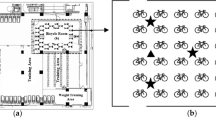Abstract
Objectives
Sumo wrestling is one of the most popular sports in Japan. Injuries are not uncommon as this is a vigorous contact sport. Sumo wrestlers have little in the way of protective clothing; their main garb is the mawashi, making them prone to exposure to any microorganisms in the dohyo. The bacterial flora of the dohyo has received little attention. If the constituent flora is identified, then appropriate treatment or prevention of any bacterial lesions or infections incurred by the wrestlers is possible.
Methods
The Vitek AMS system used in this study was developed by McDonnell Douglas Corporation. In this system, the physiological and biochemical properties of Gram-positive and negative bacilli, Gram-positive and-negative cocci, and fungi isolated from clinical materials and environments are examined using test cards specifically for each microorganism group, and the results are automatically read by a computer and encoded. Obtained codes are compared with a built-in database, and bacterial species of test strains are identified.
Results
In this study, using the automatic identification kit VITEK or ATB, we describe the aerobic bacterial flora found in the dohyo over the four seasons of the year. We also investigated the effect of salt on the bacterial flora as sumo wrestlers toss salt on the dohyo before each match. We show the relationship between salinity changes and variations in the flora observed upon the addition of salt. Without salt, at the beginning of a match, Gram-negative bacteria predominate. When salt is added, there is a transient decrease in the incidence of flora followed by an increase in the incidence Grampositive cocci.
Conclusions
Sixteen bacterial genera were identified using the bacterial identification systems in dohyo soil samples during the year. The number of identified bacterial species was 32. Even in the presence of salt, there is a measurable amount of bacterial flora in dohyo soil; salt does not act as an antibacterial agent.
Similar content being viewed by others
References
Osafune T, Ehara T, Ito T. Electron microscopic studies on bactericidal effects of electrolyzed acidic water on bacteria derived from kendo protective equipment. Environ Health Prev Med. 2006;11:206–214.
Tanaka K, Osafune T, Hakamada D, Shizawa K, Ito T. Bactericidal effects of evaporated formaldehyde againstStaphylococcus saprophyticus, Micrococcus luteus, Bacillus shaericus isolated from the men of Kendo. Japan J Phys Educ Hlth Sport Sci (Tokyo). 2000;1:35–40. (Article in Japanese)
Osafine T, Tanaka K. Identification of bacterial flora in the men of Kendo. Medicine and Biology. 2002;145:5–9. (Article in Japanese).
Kiyohara N, Kobayakawa Y, Lyman H, Osafune T. Identification of bacterial flora in the water of swimming pools throughout the year. Japan J Sport Health Sci. 2006;51:1–9.
Mitsuboshi M, Osafune T, Tanaka K, Fujimoto H, Ito T. Identification of bacterial flora on the wrestling mat by the Auto microbic system. Medicine and Biology. 2003;147:37–40. (Article in Japanese)
Minami K, Shirai Y, Nakagawa T, Mase Y, Kobayasi A, Takeuchi Y. Infectious prepatellar bursitis in student sumo player. Case report. J Clin Sports Med. 1991;8:174–176. (Article in Japanese)
Lapage SP, Bascomb S, Willcox WR, Curtis MA. Identification of bacteria by computer: General aspects and perspectives. J Gen Microbiol. 1973;77:273–290.
Isenberg HS, Sampson SJ. Clinical laboratory feasibility study of antibiotic susceptibility determined by the Automicrobic System. Current chemotherapy and infectious disease. American Soc Microbiol. 1980 p. 526–528.
Mironov A, Savitskaia KI, Vorobev AA. Opportunistic microorganisms in urinary tract diseases. Vestn Ross Akad Med Nauk. 2001;2:7–11.
Smith IM, Mandoll GL, Donglas RG, Bennett JE,Staphylococcus aureus. In: Principles and Practice of Infectious Diseases, 2. 1979. p. 1530.
Youmeus GP, Paterson PY, Sonmers HM.Staphylococci. In: The Biological and Clinical Basis of Infectious Diseases. Philadelphia: WB Saunders; 1980. p. 629–639.
Author information
Authors and Affiliations
Corresponding author
Rights and permissions
About this article
Cite this article
Osafune, T., Mitsuboshi, M., Ito, T. et al. Analysis of bacterial flora in dohyo soil. Environ Health Prev Med 12, 11–16 (2007). https://doi.org/10.1007/BF02898187
Received:
Accepted:
Issue Date:
DOI: https://doi.org/10.1007/BF02898187




